June 27 Settlement Agreement Attempts to Resolve Four Enforcement Actions Over Air Emissions From Clairton Coke Oven Batteries
JUNE 30, 2019 | POSTED BY CAC USER
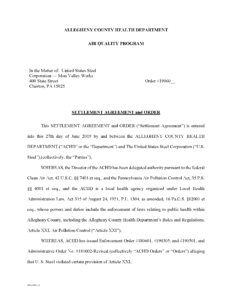
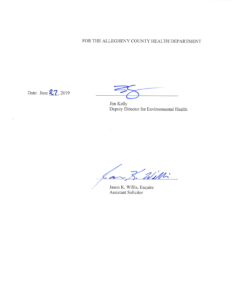
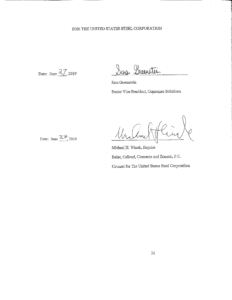
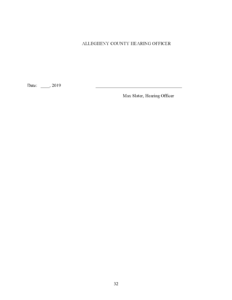
[This webpage provides an inventory of resources relating to the Proposed Settlement Agreement reached between U.S. Steel and Allegheny County Health Department on June 27, 2019.
This webpage was last updated on February 14, 2020 to include finalized Settlement Agreement and Trust Agreement and related Press Statements]
41. Press Statement of Breathe Project: Environmental Groups Identify Deficiencies in ACHD-USS Trust Agreement and Request 30-Day Public Review (February 12, 2020)
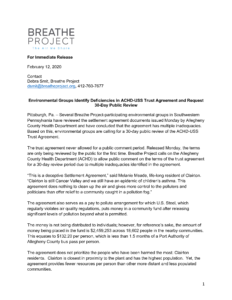
40. Press Statement of Clean Air Council: Allegheny County Health Department Finalizes Settlement with U.S. Steel, Minimal Improvements in Air Quality Expected (February 10, 2020)
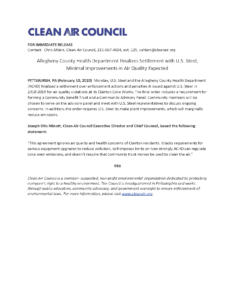
39. Press Release of Allegheny County Health Department: Health Department Finalizes Settlement Agreement and Order with U.S. Steel (February 10, 2020)

38. First Amendment to Settlement Agreement and Order (February 10, 2020)
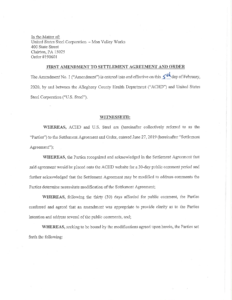
37. Settlement Agreement – Comment and Response Document, Allegeheny County Health Department (February 3, 2020)
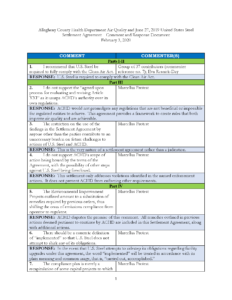
36. Community Benefit Trust Agreement, The United States Steel Corporation (January 30, 2020)
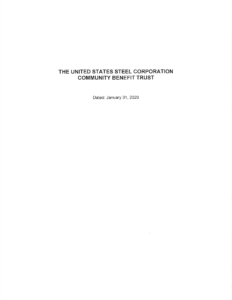
35. Allegheny County Health Department's Calculations of Quantifiable Emissions Changes Contemplated by the Proposed Settlement Agreement (July 11, 2019)
a. Email of the Allegheny County Health Department, dated July 11, 2019
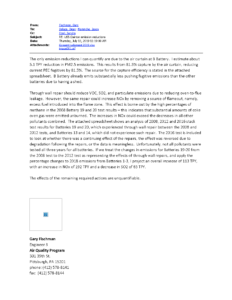
SUMMARY: An engineer of the Department summarizes the calculations of quantifiable emissions changes -- a decrease of 5.1 TPY reduction in PM2.5 emissions, an increase in NOx of 192 TPY and a decrease in SO2 of 65 TPY.
"The only emission reductions I can quantify are due to the air curtain at B Battery. I estimate about 5.1 TPY reduction in PM2.5 emissions. This results from 81.5% capture by the air curtain, reducing current PEC fugitives by 81.5%. The source for the capture efficiency is stated in the attached spreadsheet. B Battery already emits substantially less pushing fugitive emissions than the other batteries due to having a shed."
"Through wall repair should reduce VOC, SO2, and particulate emissions due to reducing oven-to-flue leakage. However, the same repair could increase NOx by removing a source of flameout, namely, excess fuel introduced into the flame zone. This effect is borne out by the high percentages of methane in the 2008 Battery 19 and 20 test results – this indicates that substantial amounts of coke oven gas were emitted unburned. The increases in NOx could exceed the decreases in all other pollutants combined. The attached spreadsheet shows an analysis of 2008, 2012 and 2016 stack test results for Batteries 19 and 20, which experienced through wall repair between the 2008 and 2012 tests, and Batteries 13 and 14, which did not experience such repair. The 2016 test is included to look at whether there was a continuing effect of the repairs, the effect was reversed due to degradation following the repairs, or the data is meaningless. Unfortunately, not all pollutants were tested all three years for all batteries. If we treat the changes in emissions for Batteries 19-20 from the 2008 test to the 2012 test as representing the effects of through wall repairs, and apply the percentage changes to 2018 emissions from Batteries 1-3, I project an overall increase of 113 TPY, with an increase in NOx of 192 TPY and a decrease in SO2 of 65 TPY."
"The effects of the remaining required actions are unquantifiable."
b. Excel spreadsheet of the Allegheny County Health Department, dated July 11, 2019

SUMMARY: The Department sets forth its calculations of quantifiable emissions changes.
34. News Coverage of Public Hearing on July 30, 2019
a. Don Hopey, Pittsburgh Post-Gazette, Benefits of Clairton Coke Works settlement agreement debated at public hearing (July 30, 2019), https://www.post-gazette.com/local/south/2019/07/30/Benefits-of-Clairton-Coke-Works-settlement-agreement-debated-at-public-hearing/stories/20190730014
b. Jamie Martines, TribLIVE, U.S. Steel settlement agreement met with praise, criticism (July 30, 2019), https://triblive.com/local/pittsburgh-allegheny/u-s-steel-settlement-agreement-met-with-praise-criticism/
c. KDKA CBS Pittsburgh, Mon Valley Holds Public Meeting On Agreement Between Allegheny County Health Department And U.S. Steel (July 30, 2019), https://pittsburgh.cbslocal.com/2019/07/30/mon-valley-holds-public-meeting-on-settlement-between-allegheny-county-health-departments-and-u-s-steel/
d. Reid Frazier, StateImpact Pennsylvania, witf, Community, workers air their responses to US Steel settlement in Clairton, (July 31, 2019), https://www.witf.org/news/2019/07/community-workers-air-their-responses-to-us-steel-settlement-in-clairton.php
e. News, wpxi.com, Community meeting airs concerns over US Steel pollution settlement (July 30, 2019), http://www.wpxi.com/news/top-stories/clairton-air-quality-community-meeting-airs-concerns-over-us-steel-pollution-settlement/971380798
f. Charlotte Hopkins, The Tube City Almanac, Health Department Hears Concerns Over U.S. Steel Agreement, http://almanac.tubecityonline.com/almanac/?e=1513
33. Comments on Proposed Agreement (July 30-31, 2019)
a. Clean Air Council (verbal comments) (2 pages)
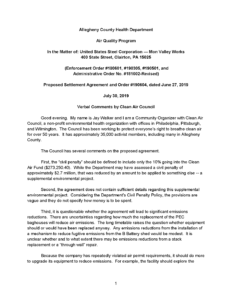
SUMMARY: The Council sets forth a verbal summary of its comments on the Proposed Agreement.
b. Clean Air Council (written comments) (15 pages, plus 145 pages in attachments)
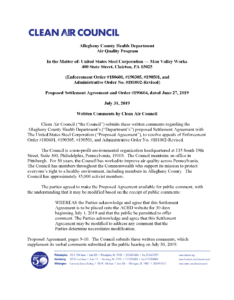
SUMMARY: The Council sets forth its written comments on the Proposed Agreement, and it attaches documents relating to the 2018 coke oven regulation initiative and noncompliance with air permit requirements following the 2016 consent order.
"1. The Department Should Revise the Proposed Agreement to Make it Clear that the “Civil Penalty” Only Includes the 10% to be Applied to the Clean Air Fund ($273,250.40).
2. The Department Has Not Established that the Proposed Trust Arrangement Would Qualify as a Supplemental Environmental Project.
3. The Department Has Not Established that the Proposed Agreement Will Lead to Significant Reductions in Air Emissions from the Clairton Facility.
4. The Department Sets Bad Policy by Perpetuating an Expectation of Less than 100% Compliance.
5. The Department Compounds Bad Policy by Restricting its Ability to Adopt Technology-Forcing Regulations.
6. The Proposed Agreement Continues to Allow the Company to “Pay to Pollute”.
7. The Proposed Agreement Fails to Provide Sufficient Information Regarding the Proposed Trust Arrangement."
c. Breathe Project and Breathe Collaborative (written comments) (7 pages)
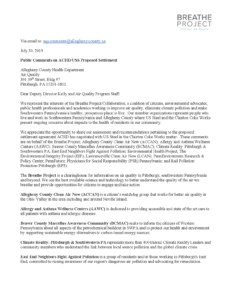
SUMMARY: The Breathe Project and Breathe Collaborative (a coalition of citizens, environmental advocates, public health professionals and academics) set forth their written comments on the Proposed Agreement.
d. Group Against Smog and Pollution (written comments) (10 pages)
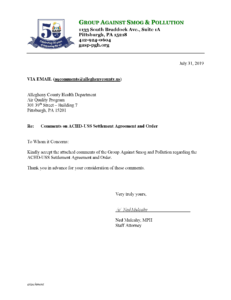
SUMMARY: Group Against Smog and Pollution sets forth its written comments on the Proposed Agreement.
e. Clean Water Action (written comments) (5 pages)
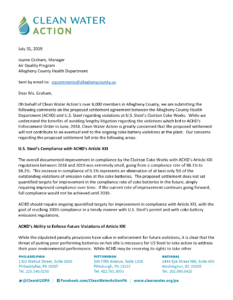
SUMMARY: Clean Water Action sets forth its written comments on the Proposed Agreement.
32. Mark Dixon (Video Producer), Video of Public Hearing Before Allegheny County Health Department, July 30, 2019 (2:28:36)
SUMMARY: This is a video presentation of verbal testimony provided by 50 individuals at the public hearing relating to the Proposed Agreement.
31. Allegheny Health County Department, Agreements and Settlements Public Comment Notice
SUMMARY: The Department is accepting written comments on the Settlement Agreement, by July 31, 2019.
"The public comment period for the listed settlement agreement begins Monday July 1, 2019 and concludes on Wednesday July 31, 2019. Written comments should be sent to:
by Mail:
Allegheny County Health Department
Air Quality
301 39th Street, Bldg #7
Pittsburgh, PA 15201-1811
by Email: aqcomments@alleghenycounty.us
by Fax: 412-578-8144"
30. Breathe Project, Letter to Allegheny County Health Department Requesting Public Hearing (July 1, 2019)
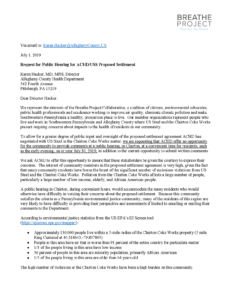
SUMMARY: In addition to the current opportunity to submit comments, the Breathe Project and Breathe Collaborative (a coalition of citizens, environmental advocates, public health professionals and academics) requests a public hearing so that community residents may express their concerns.
"To allow for a greater degree of public input and oversight of the proposed settlement agreement ACHD has negotiated with US Steel in the Clairton Coke Works matter, we are requesting that ACHD offer an opportunity for the community to provide comments at a public hearing, in Clairton, at a convenient time for residents, such as the early evening, on or near July 30, 2019, in addition to the current opportunity to submit written comments.
We ask ACHD to offer this opportunity to ensure that these stakeholders be given the courtesy to express their concerns. The interest of community members in the proposed settlement agreement is very high, given the fact that many community residents have borne the brunt of the significant number of emissions violations from US Steel and the Clairton Coke Works. Pollution from the Clairton Coke Works affects a large number of people, particularly a large number of low income, elderly, and African American people."
29. Press Release, Draft Agreement with U.S. Steel Requires Compliance with Improvement Criteria, Repair and Transparency Requirements, Community Benefit (June 28, 2019)
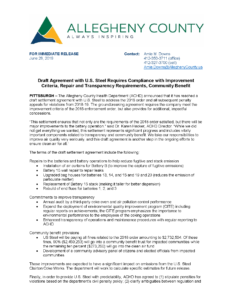
SUMMARY: The Department issues a press release summarizing the Settlement Agreement and Order executed with the company.
28. Settlement Agreement and Order (June 27, 2019)

SUMMARY: The Department and the company enter into a settlement agreement to resolve appeals of four enforcement orders pending before the Administrative Hearing Officer, with the payment of a total penalty of $2,732,504.
27. Administrative Order of Administrative Hearing Officer (June 6, 2019) (Appeal No. 19-021)
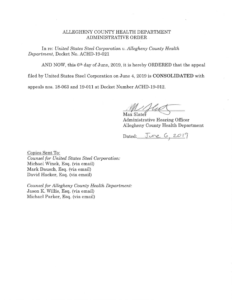
SUMMARY: Administrative Hearing Officer Max Slater consolidates the company’s appeal of the fourth enforcement order with its consolidated appeals of the second and third enforcement orders.
26. Notice of Appeal (June 4, 2019) (Appeal No. 19-021)
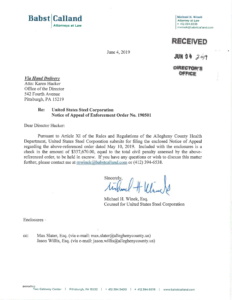
25. Enforcement Order 190501 (May 10, 2019)
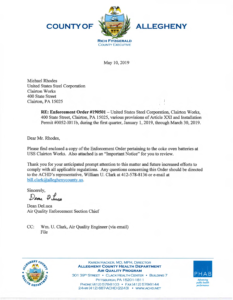
SUMMARY: In the fourth enforcement order, the Department imposes a civil penalty of $337,670 for violations during the first quarter of 2019.
24. Press Release, U.S. Steel Fined for First Quarter Violations of 2019 and Failed Stack Test (May 13, 2018)
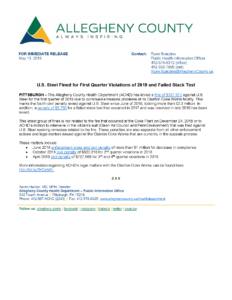
SUMMARY: The Department issues a press release regarding the fourth enforcement action, imposing a civil penalty of $337,670 for violations of air permit requirements during the first quarter of 2019.
23. Order of Administrative Hearing Officer (April 26, 2019)
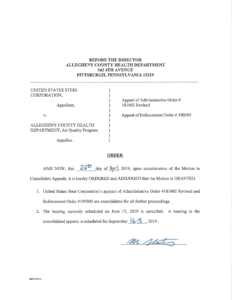
SUMMARY: Administrative Hearing Officer Max Slater consolidates the company’s appeal of the second enforcement order with its appeal of the third enforcement order, and reschedules the hearing in the consolidated appeal from June 17, 2019 to September 16-18, 2019.
22. Notice of Appeal of Enforcement Order 190305 (April 25, 2019) (Appeal No. 19-012)
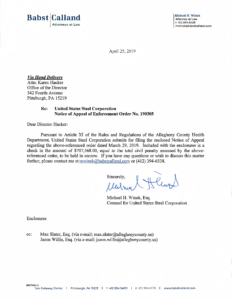
SUMMARY: The company sets forth arguments in support of its appeal of the third enforcement order.
21. Enforcement Order 190305 (March 29, 2019)
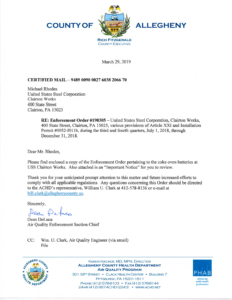
SUMMARY: In a third enforcement order, the Department imposes civil penalty of $707,568 for violations during the third quarter and fourth quarter of 2018.
20. Press Release: U.S. Steel Fined Over $700,000 for Violations in Third, Fourth Quarter of 2018 (April 1, 2019)
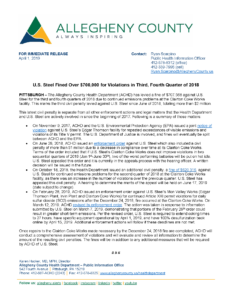
SUMMARY: The Department issues a press release regarding the third enforcement action, imposing a civil penalty of $707,568 for violations during the third quarter and fourth quarter of 2018.
19. Sur-reply Brief of U.S. Steel (March 29, 2019)
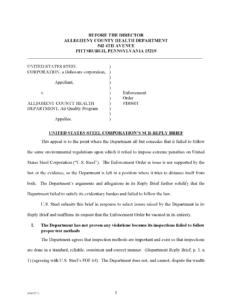
SUMMARY: The company sets forth additional legal arguments following the trial in the first appeal.
18. Reply Brief of Allegheny County Health Department (March 25, 2019)
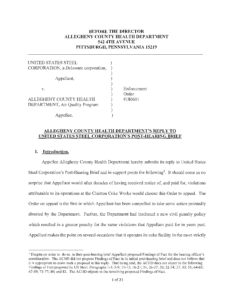
SUMMARY: The Department sets forth additional legal arguments following the trial in the first appeal.
17. Post-Hearing Brief of U.S. Steel (March 7, 2019)
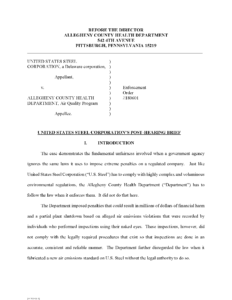
SUMMARY: The company sets forth its legal arguments following the trial in the first appeal.
16. Post-Hearing Brief of Allegheny County Health Department (February 15, 2019)
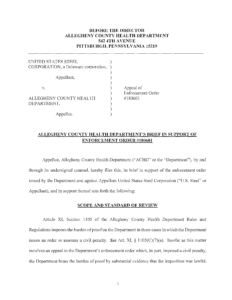
SUMMARY: The Department sets forth its legal arguments following the trial in the first appeal.
15. Letter from Administrative Hearing Officer (December 24, 2018)
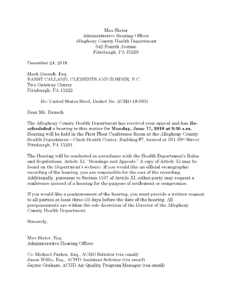
SUMMARY: Administrative Hearing Officer Max Slater schedules a hearing in the appeal of the second order on June 17, 2019.
14. Order of Administrative Hearing Officer (December 7, 2018)
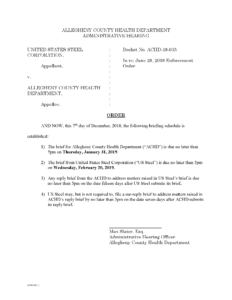
SUMMARY: Administrative Hearing Officer sets forth a schedule for filing of post-hearing briefs following the trial in the first appeal.
13. Transcript of Four-Day Hearing (December 3-6, 2018)
a. Volume 1 (Monday, December 3), pages 1-286
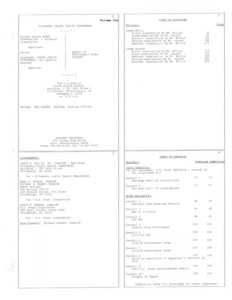
b. Volume 2 (Tuesday, December 4), pages 287-556
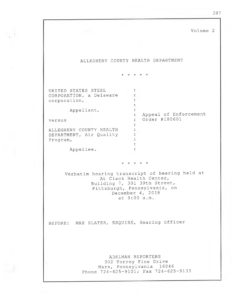
c. Volume 3 (Wednesday, December 5), pages 557-801
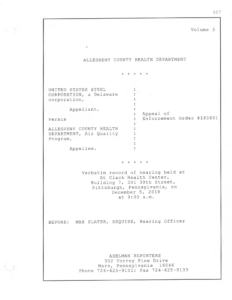
d. Volume 4 (Thursday, December 6), pages 802-981
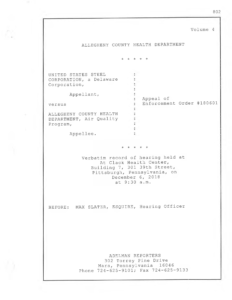
12. Pre-Hearing Statement of U.S. Steel (November 15, 2018, supplemented November 28, 2018)
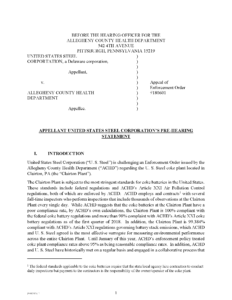
SUMMARY: The company sets forth its theory of the case in advance of trial in the first appeal.
11. Pre-Hearing Statement of Allegheny County Health Department (November 1, 2018)
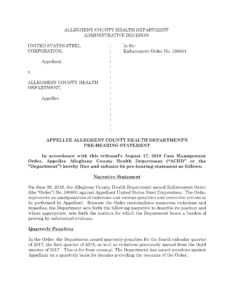
SUMMARY: The Department sets forth its theory of the case in advance of trial in the first appeal.
10. Notice of Appeal of Administrative Order 181002 Revised (December 12, 2018) (Appeal No. 18-063)

SUMMARY: The company sets forth arguments in support of its appeal of the second enforcement order.
9. Administrative Order 181002 Revised (October 31, 2018)
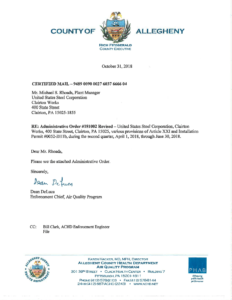
SUMMARY: In the second enforcement order, the Department imposes a civil penalty of $613,716 for violations of air permit requirements during the second quarter of 2018.
8. Press Release: Health Department Levies Fine to US Steel for 2nd Quarter Violations (October 18, 2018)
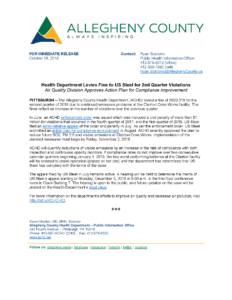
SUMMARY: The Department issues a press release regarding the second enforcement action, imposing a civil penalty of $620,316 for violations of air permit requirements in the second quarter of 2018.
7. U.S. Steel, Assessment of Coke Battery Emissions Points (August 27, 2018)
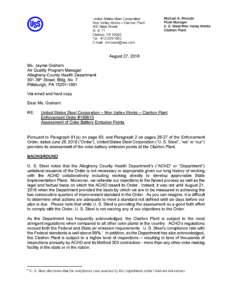
SUMMARY: The company provides an assessment of emissions points at the coke batteries, under the first enforcement order (paragraph 81(a) on page 83 and paragraph 2 on pages 26-27).
6. Amended Notice of Appeal of Enforcement Order 180601 (August 27, 2018)
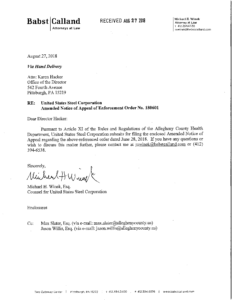
SUMMARY: The company sets forth arguments in support of its amended appeal of the first enforcement order.
5. Case Management Order in Appeal No. 18-015 (August 17, 2018)
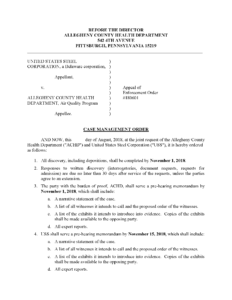
SUMMARY: The Administrative Hearing Officer sets forth a schedule for filings in the appeal of the first enforcement order.
4. Notice of Appeal of Enforcement Order 180601 (July 27, 2018) (Appeal No. 18-015)
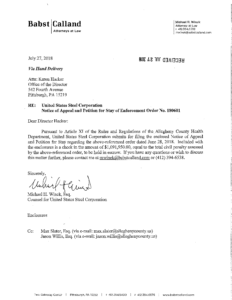
SUMMARY: The company sets forth arguments in support of its appeal of the first enforcement order.
3. Press Release, Health Department Issues Enforcement Order Against U.S. Steel (June 28, 2018)

SUMMARY: The Department issues a press release regarding the first enforcement action, imposing a civil penalty of $1,091,950 for violations of air permit requirements during the fourth quarter of 2017 and the first quarter of 2018.
2. Enforcement Order 180601 (June 28, 2018)
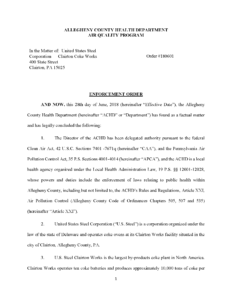
SUMMARY: In the first enforcement order, the Department imposes a civil penalty of $1,091,950 for violations of air permit requirements during the fourth quarter of 2017 and the first quarter of 2018.
1. Background: Documents Relating to Proposed Coke Oven Regulations in 2018 (Regulations Not Finalized)
In 2018, the Department proposed revisions of its coke oven regulations but has not finalized them. The following are some relevant documents.
a. Allegheny County Health Department, Coke Oven Rule Revision UPDATE, dated May 2, 2018 (presentation at Board of Health meeting).
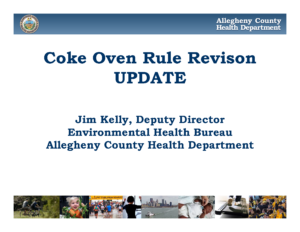
SUMMARY: This meeting handout by the Department identifies proposes changes in allowable visible emissions from door areas, allowable hydrogen sulfide concentration in coke oven gas, and removal and updating of an equipment list and dates. (page 4). The following is the rationale for the proposed change:
"Rational for Change
• Current H2S limit in the rule not protective of the SO2 NAAQS
• Align the various visible emissions standards with best performing Coke Battery
• Reduce fugitive emissions to improve compliance with H2S State standard." (page 3).
b. Allegheny County, Proposed Regulations dated June 28, 2018 (Red-lined).
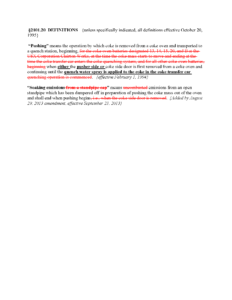
SUMMARY: This red-lined document sets forth proposed language that would make the coke oven regulations more stringent. Here are some highlights:
- for charging, reducing the period of allowable visible charging emissions from a total of 55 seconds during any five consecutive charges on a battery, to 10 seconds per charge (proposed Section 2105.21(a));
- for door areas, reducing the number of door areas where visible emissions are allowed from 5% of the door areas of the operating coke ovens in a battery, to 1 of the door areas of the coke ovens per observed battery side (proposed Section 2105.21(b)(1));
- for door areas, reducing the percentage of allowable opacity for emissions from a door area of a coke oven from 40% at any time to 30% at any time (proposed Section 2105.21(b)(2));
- for charging ports, no longer allowing visible emissions from more than 1% of the charging ports or charging port seals on the operating coke ovens of a battery, and prohibiting any such emissions (but providing that the prohibition does not apply to charging emissions) (proposed Section 2105.21(c));
- for offtake piping, no longer prohibiting visible emissions of more than 4% of the offtake piping on the operating coke ovens, and allowing visible emisisons of only one of the offtake piping on the coke ovens per observed battery side) (proposed Section 2105.21(d)(1));
- for pushing emissions, reducing the allowable opacity of pushing emissions or emissions from the pushing emission control device outlet from 20% at any time to 10% at any time (proposed Section 2105.21(e)(3));
- for combustion stacks, reducing the allowable particulate concentration from 0.015 grains per dry standard cubic foot to 0.010 grains per dry standard cubic foot (proposed Section 2105.21(f)(1)); and
- for coke oven gas, reducing the concentration of hydrogen sulfide from 70 grains per hundred dry standard cubic feet (or the concentration determined by formula, whichever is less) to 35 grains per hundred dry standard cubic feet (or the concentration determined by formula, whichever is less) (proposed Section 2105.21(h)(1)).
c. Allegheny County Health Department, Letter to U.S. Steel, dated August 1, 2018.
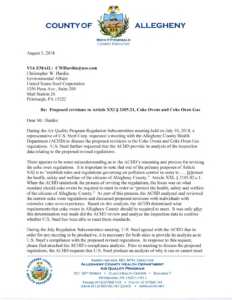
SUMMARY: The Department asserts that its proposed revisions were based first on a consideration of health, safety, and welfare, and then on a consideration of the company's ability to meet the proposed standards. The letter also attaches compliance data for 2017.
"When the ACHD undertook the process of revising the regulations, the focus was on what standard should coke ovens be required to meet in order to "protect the health, safety and welfare of the citizens of Allegheny County." As part of this process, the ACHD analyzed and reviewed the current coke oven regulations and discussed proposed revisions with individuals with extensive coke oven experience. Based on this analysis, the ACHD determined what requirements that coke ovens in Allegheny County should be required to meet. It was only after this determination was made did the ACHD review and analyze the inspection data to confirm whether U.S. Steel has been able to meet these standards."
d. U.S. Steel, Letter to Allegheny County Health Department, dated August 6, 2018.
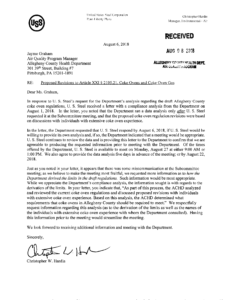
SUMMARY: The company requests information regarding the Department's analysis of "how the Department derived the limits in the draft regulations."
"We respectfully request information regarding this analysis (as to the derivation of the limits as well as the names of the individuals with extensive coke oven experience with whom the Department consulted). Having this information prior to the meeting would streamline the meeting."
e. U.S. Steel, Letter to Allegheny County Health Department, dated August 22, 2018.
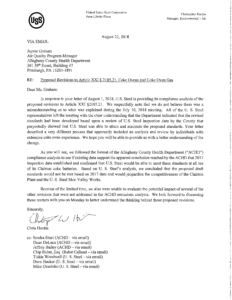
SUMMARY: The company states that the understanding of the parties was that the Department was basing its standards on the ability of the company to comply with them, and not on an analysis and review by individuals with extensive coke oven experience. The letter attaches spreadsheets estimating and increase in the number of violations under the proposed regulations.
"We respectfully note that we do not believe there was a misunderstanding as to what was explained during the July 10, 2018 meeting. All of the U. S. Steel representatives left the meeting with the clear understanding that the Department indicated that the revised standards had been developed based upon a review of U.S. Steel inspection data by the County that purportedly showed that U.S. Steel was able to attain and maintain the proposed standards. Your letter described a very different process that apparently included an analysis and review by individuals with extensive coke oven experience. We hope you will be able to provide us with a better understanding of the change."
f. Allegheny County Health Department, Letter to U.S. Steel, dated September 14, 2018.
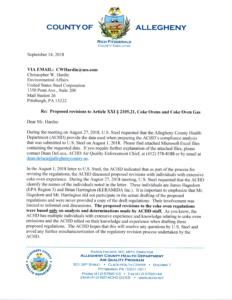
SUMMARY: Responding to a request by the company, the Department identifies the names of individuals with extensive coke oven experience with whom it discussed proposed revisions of the coke oven regulations.
"As you know, the ACHD has multiple individuals with extensive experience and knowledge relating to coke oven emissions and the ACHD relied on their knowledge and experience when drafting these proposed regulations."
g. U.S. Steel, Meeting Handout for Allegheny County Health Department, dated October 9, 2018.
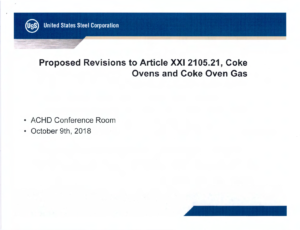
SUMMARY: The company sets forth its legal and factual positions criticizing the proposed regulations.
"• To date, U. S. Steel has not identified any other by-product coke
battery that can continuously achieve compliance with the current
Article XXI standards let alone the proposed Article XXI standards.
• U. S. Steel is working with Thyssen Krupp Industrial Solutions (TKIS).
- TKIS is a world leader in coke oven battery operations and technology
- TKIS is reviewing the proposed coke oven regulations to see if any battery on a world-wide scale is capable of meeting the standards on a continuous basis.
...
Proposal:
• Defer consideration of the revised coke oven standards until
completion of the approved U. S. Steel's battery assessment
and associated plan.
• If at that time, the ACHD determines that existing ambient
standards or other regulatory requirements are not being met,
develop a plan that is specifically designed to address the
issue." (pages 8, 13).
h. Allegheny County Health Department, Administrative Order dated March 6, 2019.
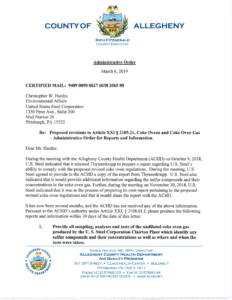
SUMMARY: The Department issues an Administrative Order requiring the company to produce reports and information that it had stated it would provide but had not yet provided.
"During the meeting, U.S. Steel agreed to provide to the ACHD a copy of the report from Thyssenkrupp. U.S. Steel also indicated that it would provide additional information regarding the sulfur compounds and their concentrations in the coke oven gas. Further, during the meeting on November 30, 2018, U.S. Steel indicated that it was in the process of preparing its own report pertaining to the proposed revised coke oven regulations and that it would share the report with the ACHD.
It has now been several months, and the ACHD has not received any of the above information."